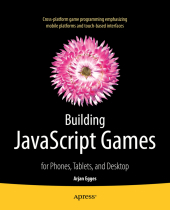 Neuerscheinungen 2014Stand: 2020-02-01 |
Schnellsuche
ISBN/Stichwort/Autor
|
Herderstraße 10
10625 Berlin
Tel.: 030 315 714 16
Fax 030 315 714 14
info@buchspektrum.de |

Arjan Egges
Building JavaScript Games
for Phones, Tablets, and Desktop
1st ed. 2014. xxvii, 444 S. 91 SW-Abb. 254 mm
Verlag/Jahr: SPRINGER, BERLIN; APRESS 2014
ISBN: 1-430-26538-8 (1430265388)
Neue ISBN: 978-1-430-26538-2 (9781430265382)
Preis und Lieferzeit: Bitte klicken
Building JavaScript Games teaches game programming through a series of engaging, arcade-style games that quickly expand your JavaScript and HTML5 skills. JavaScript is in the top ten most-used programming languages world wide, and is the basis for applications that can run in any modern browser, on any device from smart phone to tablet to PC. Especial emphasis is given to touch-based interface, but all games also run using a regular mouse and keyboard setup.
The four games you´ll develop from reading this book are:
Painter
Jewel Jam
Penguin Pairs
Tick Tick
These four games are casual, arcade-style games representing the aim-and-shoot, puzzle, maze, and platform styles of game play.
The approach in Building JavaScript Games follows the basic structure of a game rather than the syntax of a language. From almost the very first chapter you are building games to run on your phone or other device and show to your friends. Successive projects teach about handling player input, manipulating game objects, designing game worlds, managing levels, and realism through physics. All told, you´ll develop four well-designed games, making Building JavaScript Games one of the most enjoyable ways there is to learn about programming browser-based games.
The final chapters in the book contain a very nice bonus of sorts. In them you will find excerpts from interviews with two prominent people from the game industry: Mark Overmars, who is CTO of Tingly Games and creator of GameMaker, and Peter Vesterbacka, the CMO of Rovio Entertainment - the creators of the Angry Birds franchise. Their insight and perspective round off what is already a fun and valuable book.
Part I
1 - Programming
2 - Game Programming Basics
3 - Creating a Game World
4 - Game Assets
Part II
5 - Knowing What the Player is Doing
6 - Reacting to Player Input
7 - Basic Game Objects
8 - Game Object Types
9 - Colors and Collisions
10 - Limited Lives
11 - Organizing Game Objects
12 - Finishing the Game
Part III
13 - Adapting to Different Devices
14 - Game Objects in a Structure
15 - Gameplay Programming
16 - Game States
17 - Finishing the Game
Part IV
18 - Sprite Sheets
19 - Menus and Settings
20 - Game State Management
21 - Storing and Recalling Game Data
22 - Pairing the Penguins
23 - Finishing the Game
Part V
24 - The Main Game Structure
25 - Animation
26 - Game Physics
27 - Intelligent Enemies
28 - Adding Player Interaction
29 - Finishing the Game
Part VI
30 - Efficient and Readable Code
31 - Deploying your Game
Arjan Egges is an associate professor in Computer Science at Utrecht University in the Netherlands. He is responsible there for research in the area of computer animation, and he heads the university s motion capture lab in the animation department. Arjan has written over 30 research papers on animation. He is the founder of the highly successful, annual ACM SIGGRAPH conference on Motion in Games, of which the proceedings have been published by Springer-Verlag. Arjan is responsible for having designed Utrecht University s computer animation course offerings in the Game and Media Technology master s program, and he is currently the leader of that master s program. In 2011 he designed the introductory programming course for the university s bachelor s degree offering in Game Technology. He is coauthor of the book Learn C# by Programming Games, published in 2013 by Springer.


